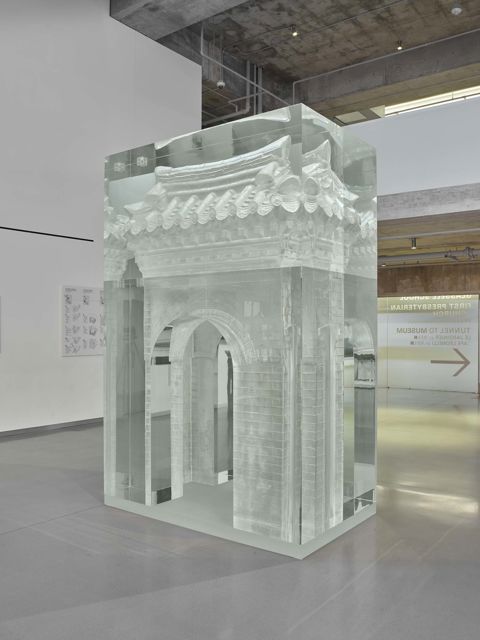The Museum of Fine Arts, Houston, installs “Portal” by Do Ho Suh, an “impossible” sculpture made from the negative form of a traditional Korean gate

Do Ho Suh, Portal, 2015, acrylic resin, the Museum of Fine Arts, Houston, Museum commission funded by the Caroline Wiess Law Accessions Endowment Fund and gift of the artist. © 2015 Do Ho Suh
The MFAH-commissioned piece expresses, in Do Ho Suh’s words, the intent to “draw out these intangible qualities of energy, history, life, and memory”
HOUSTON—February 6, 2024—Commissioned by the MFAH in 2006 and produced over a decade with support from collaborators in Maryland, New York, and Colorado, Do Ho Suh’s Portal (2015) has taken its place in the Nancy and Rich Kinder Building of the Museum of Fine Arts, Houston, adjacent to the entrance to the Glassell School of Art. It is installed alongside two other major works commissioned for the opening of the Kinder Building: Ólafur Elíasson’s Sometimes an underground movement is an illuminated bridge and Ai Weiwei’s Dragon Reflection (both 2020).
Portal stands eleven feet high, eight feet across and two feet deep. Described by Do Ho Suh as an “impossible” sculpture, Portal is at once monumental, at nine tons in weight, and seemingly ephemeral, as the exquisitely milled acrylic captures light and reflection, remaining essentially transparent as it encases the image of a traditional Korean gate in negative space.
“Some things in a museum’s life truly merit waiting for the right moment,” commented Gary Tinterow, director and Margaret Alkek Williams chair of the Museum of Fine Arts, Houston. “This extraordinary, deeply resonant piece was originally commissioned from Do Ho Suh by Peter C. Marzio, the Museum’s longtime director, to celebrate the 2007 opening of its Arts of Korea gallery. As Suh developed his concept, and the Museum began to recognize the production and engineering that it entailed, it became clear that its creation would be a lengthy process. After Portal was completed, in 2015, we determined to hold it in storage until we could identify its rightful place in the newly developed Sarofim Campus. That moment has arrived.”
The initial brief of the commission was to create a metaphorical gateway that would bridge the historic arts of Korea with the present moment. The artist in turn began work on a seemingly contradictory project—to “make something out of nothing”—casting the negative form of a traditional Korean gate, based on an 18th-century style, in solid acrylic resin. Working closely with Jon Lash and Ron Elad to scan, engineer, and fabricate Portal, as well as with former MFAH curator Christine D. Starkman, Suh also challenged himself to reconsider his personal history, taking into consideration the role of both artist and museum in the 21st century, as well as the relationship between East and West.
The concept of home, ideas of displacement, and of transitional spaces have remained conceptual touchstones across Suh’s career. Portal specifically summons up the artist’s powerful family legacy, shaped by Korea’s history of war and colonial oppression in the 20th century, which destroyed much of the nation’s capital city, Seoul. In the years of reconstruction that followed, Do Ho Suh’s father, Suh Se Ok, himself an artist renowned for his ink paintings, built a home for his family with a classical entry portal based on an 18th-century gate. Translated into a transparent shell, this domestic fragment becomes a liminal presence. “The gate or portal is a marker that invites the viewer to enter into a different physical or psychological dimension–outside/inside, or public/private,” Suh has stated. “But it has a dual purpose in that it is also a place in itself, often as distinct as those spaces it is designed to connect.” He commented further on the specific nature of Portal: “It really needs to be seen in person. Literally and figuratively, it is so transparent—there’s no trick whatsoever—but it creates this incredible illusion because of the way the light hits the milled surface. You sense gravity, the density of weight, in a different way.”
About the Artist
Do Ho Suh (born 1962, Seoul, Korea; lives and works in London, United Kingdom) confronts questions of home, physical space, displacement, memory, individuality, and collectivity. Suh is best known for his fabric sculptures that reconstruct to scale his past and present homes and studios in Korea, Rhode Island, Berlin, London, and New York. For Suh, the spaces we inhabit also contain psychological energy. His work makes visible those markers of memories, personal experiences, and a sense of security, regardless of geographic location.
After completing his initial studies at Seoul National University and his mandatory military service, Suh traveled to the United States, where he received a B.F.A. in painting from Rhode Island School of Design in 1994 and an M.F.A. in sculpture from Yale University in 1997. He entered the international stage in 2001 when he represented Korea at the 49th Venice Biennial.
About the Museum of Fine Arts, Houston
Spanning 14 acres in the heart of Houston’s Museum District, the Fayez S. Sarofim Campus of the MFAH comprises the Audrey Jones Beck Building, the Caroline Wiess Law Building, the Nancy and Rich Kinder Building, and the Lillie and Hugh Roy Cullen Sculpture Garden. Nearby, two house museums—Bayou Bend Collection and Gardens, and Rienzi—present collections of American and European decorative arts. The MFAH is also home to the Glassell School of Art, with its Core Residency Program and Junior and Studio schools; and the International Center for the Arts of the Americas (ICAA), a leading research institute for 20th-century Latin American and Latino art.
Media Contact
Melanie Fahey, Senior Publicist
mfahey@mfah.org | 713.800.5345
